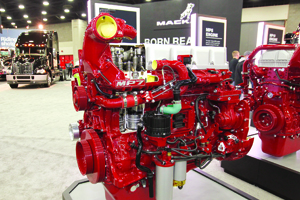Features Editor
Fuel Efficiency Driving Greater Use of Smaller Engines

This story appears in the April 11 print edition of Equipment & Maintenance Update, a supplement to Transport Topics.
With more regulations on greenhouse-gas emissions and fuel economy coming soon, smaller engines are one of the latest equipment trends, according to one of the cover stories in this issue of Equipment & Maintenance Update. Contributing writer Evan Lockridge notes that these encompass not just the 13-liter variety, but those around 11 to 12 liters, too.
 Matso Lysiak
Matso LysiakThe larger 15-liter models deliver lots of torque and horsepower — and generally, fleet operators want to get as much of those commodities as they want or can afford, according to the story. In certain instances, though, larger displacement may not always mean all that much more horsepower.
“We are able to achieve more horsepower and torque with less displacement,” according to Charlie Cook, marketing manager of vocational products at Peterbilt Motors, a unit of Paccar Inc. Earlier this year, Paccar installed in the United States its first production MX-11 engine. Cook said the power plant’s 430 horsepower and 1,550 pound-feet of torque would have required a much larger engine a few years ago.
BEST OF APRIL E&MU: More stories, columns
As some of the industry experts who comment in the story point out, much of the move to smaller engines is due to fuel efficiency. Other original equipment manufacturers offer smaller engines, too. And read the story to find out which engine maker is not yet on-board in offering an 11-liter engine.
The other front page story looks at lower material and commodity prices. At first glance, it seems this should translate into lower prices for trucks, trailers and components, but that hasn’t necessarily been the case.
As contributing writer Jim Galligan reports, steel and aluminum are leading a long list of materials and commodities whose prices have fallen sharply over the past year as industrial economies slowed, most notably China, but also Russia. For example, spot prices for steel are down 40% to 50%, depending on the type, compared with 2014.
“We’re in uncharted territory with these prices,” said Steve Mance, CEO of Defiance Metal Products, a metal component manufacturer in Ohio. However, the lower material and commodity prices do not flow dollar-for-dollar through the supply chain and are not translating into across-the-board discounts for truck and component buyers — at least not yet.
There are several reasons — primarily on the manufacturing side. Read and find out.
As for the author of what you’re reading, I’m the new equipment editor at Transport Topics and the editor of E&MU. Earlier this year I joined after longtime editor Bruce Harmon retired.
Before TT, I was an editor and reporter for 11 years covering the world of insurance. I’m hoping that if I was able to report on guaranteed living benefit riders on variable annuities, I’ll be able to tackle turbo compounding and waste-heat recovery.
I’m finding that trucks and all of their inner workings and related equipment and components also are fascinating. An inquiring mind can translate into timely stories of interest to readers.
I welcome your story ideas. Please send to: flysiak@ttnews.com, or call me at 703-838-1937. And thanks for continuing to read E&MU.

